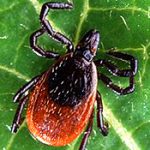Ixodes scapularis is commonly known as the deer tick or blacklegged tick and in some parts of the USA as the bear tick. It is a hard-bodied tick of the eastern and northern Midwestern United States. It is a vector for several diseases of animals and humans (Lyme disease, babesiosis, anaplasmosis, etc) and is known as the deer tick due to its habit of parasitizing the white-tailed deer.
The image shown to the right is an adult that is unengorged, that is, an adult that has not had a blood meal. This is natural, since the ticks are generally removed immediately upon discovery to minimize the chance of disease. However, the abdomen that holds blood is so much larger when engorged and looks so different from the rest of the tick that it would be easy to assume that an engorged specimen of Ixodes scapularis is an entirely different tick (see photo on lower left). The abdomen is of a light grayish-blue color, whereas the tick itself is chiefly black. In identifying an engorged tick, it is helpful to concentrate on the legs and upper part of the body.
Deer tick females latch onto a host and drink its blood for four to five days. After it is engorged, the tick drops off and overwinters in the leaf litter of the forest floor. The following spring, the female lays several hundred to a few thousand eggs in clusters.
Co-infections complicate Lyme symptoms, especially diagnosis and treatment. It is possible for a tick to carry and transmit one of the co-infections and not Borrelia, making diagnosis difficult and often elusive. The Centers for Disease Control (CDC)’s emerging infections diseases department did a study in rural New Jersey of 100 ticks and found that 55% of the ticks were infected with at least one of the pathogens.

